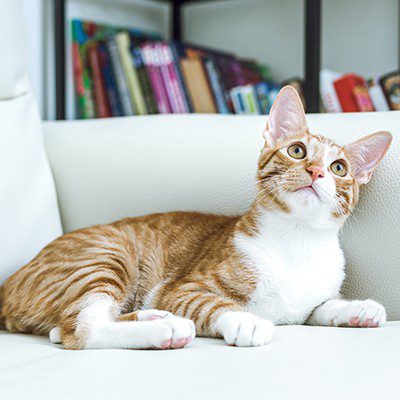If you own a cat, you know that they can sometimes be a bit aloof. One of the best ways to tell what your cat might be thinking or feeling is by studying their body language. While it’s not an exact science, there are a few traits common across most cats that are good indicators of your feline friend’s mood. Learn more below:
Experts agree: your cat’s tail is one of the best gauges of their temperament. Most of the time, you’ll see your pet keep her tail in the “default” position when walking around; the tail will be held upright in a gentle fashion. A raised tail with a curl means your cat is feeling comfortable and playful, while wrapping the tail around your legs—or around another cat or pet in the house—is a sign of affection.
A tail that’s held rigidly straight up in the air, puffed with hair jutting out wildly, is a sign that your cat is alarmed and ready to defend herself. This tail position is likely to be accompanied by widened eyes, a hiss, and a crouched front half with claws extended. If you see this type of body language, it’s best to get out of the way!
As mentioned above, wide eyes mean that your cat is frightened or tense. Generally speaking, the wider your cat’s eyes are, the more anxious she is—and the more ready she is to defend herself or retreat.
Have you ever seen your cat blink slowly at you? The slow-blink is another piece of your cat’s body-language puzzle. Since closing the eyes around other pets or people is a sign of trust, the slow-blink is a way of communicating affection. Sometimes, cat owners are able to slow-blink at their cat and get a slow-blink in return… try it with your feline friend!
When your cat is alert and focused on something, you’ll probably see the ears pointed upward and cocked forward. Pointed ears could also indicate tension or alarm. Ears that are upright but turned backward indicate that your cat is alarmed—she’s ready to bolt or defend herself if necessary.
Remember: every cat is different and might display certain body language traits that are unique to them. To learn more about your feline friend’s behavior, or to set up an appointment for an exam, call the office today.
